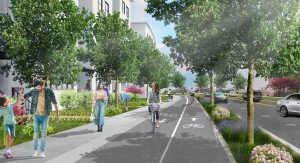Posted on: August 12, 2024
Source: Bisnow; Author: John Krukowski

A rendering shows the proposed transformation of Ring Road to accommodate pedestrians, bikes and cars for the Global Villages development.
While the automobile was a driving force in the rise of suburbs like Atlanta’s Gwinnett County, today it is not the only transportation option that local planners and politicians must manage for this diverse county of 1 million people — particularly in light of the proposed redevelopment of the old Gwinnett Place Mall.
The ambitious Global Villages plan, which would transform the mall site into a mixed-use development with residential, commercial, cultural and green space elements, is projected to add nearly 30,000 local trips per day to local roads and footpaths. To prepare its transportation infrastructure for this growth, the Gwinnett Place Community Improvement District has proposed more than 30 projects worth nearly $117M that would bring significant improvements to local pedestrian walkways, intersections, roads and bridges.
What sets these plans apart from transportation projects of the past is the recognition that not all those thousands of additional trips will begin in someone’s driveway, said Lewis Cooksey, director of the county department of transportation. Instead, many residents may start their commutes at a local bus stop or even from home.
Whichever way residents choose to get around, local officials want to ensure their commutes are as safe and convenient as possible, he said.
“Equity and sustainability are key components of the redevelopment of the mall site, and we want the transportation aspects of the redevelopment to meet those goals in such a way that you could be a single-car household or a no-car household and still be able to get to wherever you need to go in Gwinnett County,” Cooksey said.
Cooksey pointed to a couple of recent announcements that he said show the county takes transportation seriously.
First, with the help of a $20M federal Rebuilding American Infrastructure with Sustainability and Equity — or RAISE — grant, the county is moving forward with plans to upgrade the existing Gwinnett Place Transit Center located near the mall.
Currently a simple bus stop with limited shelter against the elements, the location will be redeveloped into a modern, two-story building featuring on-site customer service and 12 bus bays. An attached mobility building will provide space for training and mobility assistance.
“The grant will allow us to transform this location into a gathering and transfer place for whatever mode of travel you need,” Cooksey said. “It is a critical hub in our transportation network.”
In November, Gwinnett County voters will weigh in on a referendum to impose a 1% sales tax for 30 years that would fund as many as 75 local transportation projects.
Cooksey said the Special Purpose Local Option Sales Tax — or SPLOST — would create a sustainable funding source. Its impacts could include improved transportation to Hartsfield-Jackson Atlanta International Airport, expanded local bus service, additional transit transfer facilities and the expansion of a demand-responsive microtransit service that uses smaller vehicles to take residents anywhere in the county.
“The transit plan we have today is different from any plan we have ever had, because there is something in it for everyone, whether you need a ride to the airport or rely on microtransit to get around the county,” Cooksey said. “Every inch of Gwinnett County is going to be covered in microtransit zones.”
While these improvements are meant to benefit people across Gwinnett County, they will also play an important role in the redevelopment of the nearly 90-acre Gwinnett Place Mall site, he said.
“Gwinnett Place is a growing area in a central location that makes it a natural focal point for our transportation investments,” Cooksey said. “In addition, the county purchased the mall property, and we want to get the highest return on our investment.”
Today, the mall’s acres of parking, built to accommodate an earlier, car-centric era, sit mostly unused while Gwinnett County plans for its future. But Cooksey said the county recognizes that it will need to support “multiple modes of mobility” to continue to grow.
“We need ways for everyone to get around, whether they are a pedestrian or cyclist, an Amazon truck driver or someone who’s just passing through,” he said. “We’re looking out for all of them, which requires a multimodal approach that will use every tool we have in our transportation toolbox.”
Read the full article here.
Posted in: News